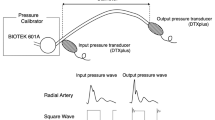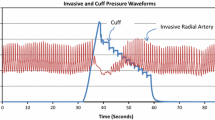Abstract
Methods used in clinical practice to increase the damping of a transducer hydraulically coupled to an intraarterial blood-pressure monitoring system often decrease the undamped natural frequency of the system. This leads to spuriously high systolic and low diastolic pressure readings. The ROSE damping device is being marketed as a possible solution to the problem. We tested the dynamic response of three different catheter systems, with various pressure-tubing lengths of 1 to 7 feet (30.5 to 213.4 cm), with and without the ROSE damping device. The device was able to substantially increase damping and at the same time maintain the undamped natural frequency. Typically it increased the damping coefficient from a minimum of 0.17±0.01 to a minimum of 0.33±0.01, while never significantly decreasing the undamped natural frequency. In testing a sample of 25 devices we did observe, however, a wide variability in damping characteristics among different devices. Damping coefficients ranged between 0.19 and 1.20.
Similar content being viewed by others
References
Bruner JMR. Handbook of blood pressure monitoring. Littleton, MA: PSG, 1978:20–27
Hansen AT, Warburg E. The theory for elastic liquid-containing membrane manometers. Acta Physiol Scand 1949;19:306–331
Gardner RM. Direct blood pressure measurement-dynamic response requirement. Anesthesiology 1981;54:227–236
Hansen AT. Pressure measurement in the human organism. Acta Physiol Scand [Suppl] 1949;19[68]:1–227
Fry DL. Physiologic recording by modern instruments with particular reference to pressure recording. Physiol Rev 1960;40:753–787
Warburg E. A method of determining the undamped natural frequency and the damping in overdamped and slightly underdamped systems of one degree of freedom by means of a square-wave impact. Acta Physiol Scand 1950;19:345–349
Shinozaki T, Deane RS, Matuzan JE. The dynamic responses of liquid-filled catheter systems for direct measurements of blood pressure. Anesthesiology 1980;53:498–504
Hunziker P. Accuracy and dynamic response of disposable pressure transducer-tubing systems. Can J Anaesth 1987;34:409–414
Van Der Tweel LH. Some physical aspects of blood pressure, pulse wave and blood pressure measurements. Am Heart J 1957;53:4–17
Abrams JH, Olson ML, Marino JA, Cerra FB. Use of a needle valve variable resistor to improve invasive blood pressure monitoring. Crit Care Med 1984;12:978–982
Author information
Authors and Affiliations
Rights and permissions
About this article
Cite this article
Kleinman, B., Powell, S. Dynamic response of the rose damping device. J Clin Monitor Comput 5, 111–115 (1989). https://doi.org/10.1007/BF01617884
Received:
Revised:
Accepted:
Issue Date:
DOI: https://doi.org/10.1007/BF01617884




